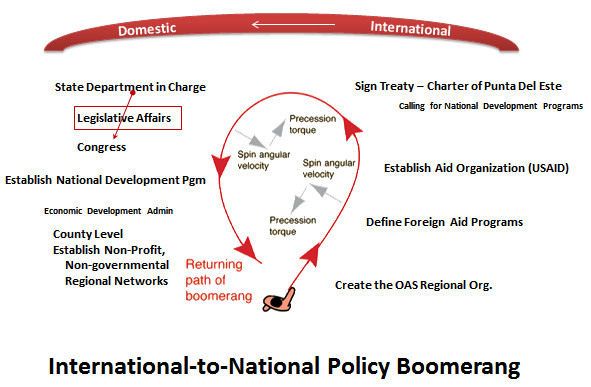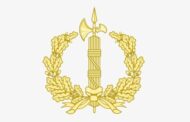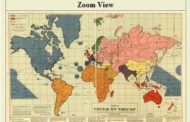In September of 1960, the Act of Bogota was signed establishing the social and economic goals for signatories of the Organization of American States (OAS) within the framework of Operation Pan America. The ultimate purpose as we’ve come to know was a plan for a Common Market of the Americas – same as the European Union is for the nation-states of Europe.
The purpose of the Act as described on the Yale Law School website – Avalon Project:
Text of Act of Bogota, recommending Measures for Social Improvement and Economic Development within the Framework of Operation Pan America, adopted by the Council of the Organization of American States on September 13, 1960, and approved by the Council in a resolution dated October 11, 1960
On January 20, 1961 in his Inaugural Address, the newly elected President John F. Kennedy said the following:
“To our sister republics south of our border, we offer a special pledge – to convert our good words into good deeds – in a new alliance for progress – to assist free men and free governments in casting off the chains of poverty.” —
The Organization for European Economic Co-operation (OEEC) was created by Marshall Plan to rebuild Europe post World War II. In 1961, the organization was renamed and re-purposed to become a global manager of economic and social development. The new name of the organization was and is the Organization for Economic Co-operation and Development (OECD).
In March of 1961, President John F. Kennedy gave an Address at a White House Reception for members of Congress and the Diplomatic Corp in which he outlined his ten-year plan. (Note: the link is to a video).
In May of 1961, President Kennedy gave a speech before the Canadian Parliament in Ottawa suggesting that “through the Organization of Economic Cooperation and Development and the Development Assistance Group, we can pool our vast resources and skills, and make available the kind of long-term capital, planning and know-how without which these nations will never achieve independent and viable economies, and without which our efforts will be tragically wasted. I propose further that the OECD establish a Development Center, where citizens and officials, and students and professional men of the Atlantic area and the less-developed world can meet to study in common the problems of economic development.
To support Operation Pan America and the Alliance for Progress, a lot of legislation was passed to provide the funding and authorization for the organizational structures. List of 1961 legislation. The Agency for International Development (USAID) was created by Executive Order 10973 with authority delegated to the Secretary of State.
On August 17, 1961 the Charter of Punta del Este was signed by all members of the Organization of American states – except Cuba:
Title I. Objective of the Alliance for Progress
It is the purpose of the Alliance for Progress to enlist the full energies of the people and governments of the American republics in a great cooperative effort to accelerate the economic and social development…
Title II. Economic and Social Development
Chapter I. Basic Requirements for Economic and Social Development
Chapter II. National Development Programs
a. Improvement of human resources and widening of opportunities by raising general standards of education and health; improving and extending technical education and professional training with emphasis on science and technology; providing adequate remuneration for work performed, encouraging the talents of managers, entrepreneurs, and wage earners; providing more productive employment for underemployed manpower; establishing effective systems of labor relations, and procedures for consultation and collaboration among public authorities, employer associations, and labor organizations; promoting the establishment and expansion of local institutions for basic and applied research; and improving the standards of public administration.
So that’s the origin of the national economic development structure. Economic Development (as a noun) was marketed as an international aid program. It was then boomeranged back into a domestic program through the international agreement which puts the State Department in the driver’s seat. President Kennedy was assassinated on November 22, 1963 and Lyndon Baines Johnson was sworn in as President.
1965
The hallmark of the Johnson Administration was The Great Society. Johnson appointed John W. Gardner to be the Secretary of Health, Education and Welfare. Gardner is the acknowledged architect of the Great Society programs. The Economic Development Administration (EDA) was created by the Public Works and Economic Development Act of 1965 (PWEDA). HUD was created by the Department of Housing and Urban Development Act of 1965. Both agencies were created as Great Society programs.
John W. Gardner was President of the Carnegie Corporation 1955 to 1967. Notice there is an overlap where he served simultaneously as Secretary of HEW and President of the Carnegie Corporation.
The following is from Gardner’s bio on the Carnegie Corporation website – emphasis added:
“With Gardner, the Corporation entered the era of strategic philanthropy — the planned, organized, deliberately constructed means to attain stated ends. It no longer sufficed to support a socially desirable project; rather, the knowledge must produce concrete results and be communicated to the public, the media, and decision makers with the intention of fostering policy debate. A central objective was to develop programs that might be implemented and scaled up by larger organizations, especially government. The turn toward “institutional transfer” was partly in response to the relatively diminished power of the Corporation’s resources, making it necessary to achieve “leverage” and “multiplier effects” if it was to have any impact at all.”
It appears that the design of the Great Society programs was to have domestic policy outsourced to the OECD with federal money to implement those policies flowing through the private – non-profit organizations, foundations and regional organizations that can’t be affected by the voters.
After leaving his position as Secretary of Health, Education and Welfare, John W. Gardner founded two organizations – no doubt with Carnegie money:
Common Cause and the Independent Sector
From the Independent Sector website:
“Independent Sector is the leadership network for nonprofits, foundations, and corporations committed to advancing the common good. Our nonpartisan coalition’s networks collectively represent tens of thousands of organizations and individuals locally, nationally, and globally.”
From PBS on the Independent Sector (Great Society programs created the PBS)
“In 1978, when John Gardner was 66 (an age at which most people are ready to retire), Gardner left Common Cause to become chairman of the Commission on White House Fellowships. Two years later, he co-founded Independent Sector, an organization to help coordinate and advocate for the vast array of non-profit groups — from churches to schools, hospitals to neighborhood associations. Having just left as chairman of Common Cause, Gardner recognized the power of non-profit groups to help communities from the grassroots up. Independent Sector would become a coalition of 800 corporate, foundation, and voluntary organizations that encourage giving and volunteering in America.“
From PBS on Common Cause
Related Reading:
Operation Pan America
Alliance for Progress
La Paz: U.S.-Mexico Regionalism









2 Comments
kristin
Vicky I would like to hear your take on this: “Global Supply Chain by Amazon,” as soon as this year, the documents said. The new business will locate Amazon at the center of a logistics industry that involves not just shippers like FedEx and UPS but also legions of middlemen who handle cargo and paperwork associated with transnational trade.
Pingback: Importing Tyranny Through International Agreement – Abel Danger